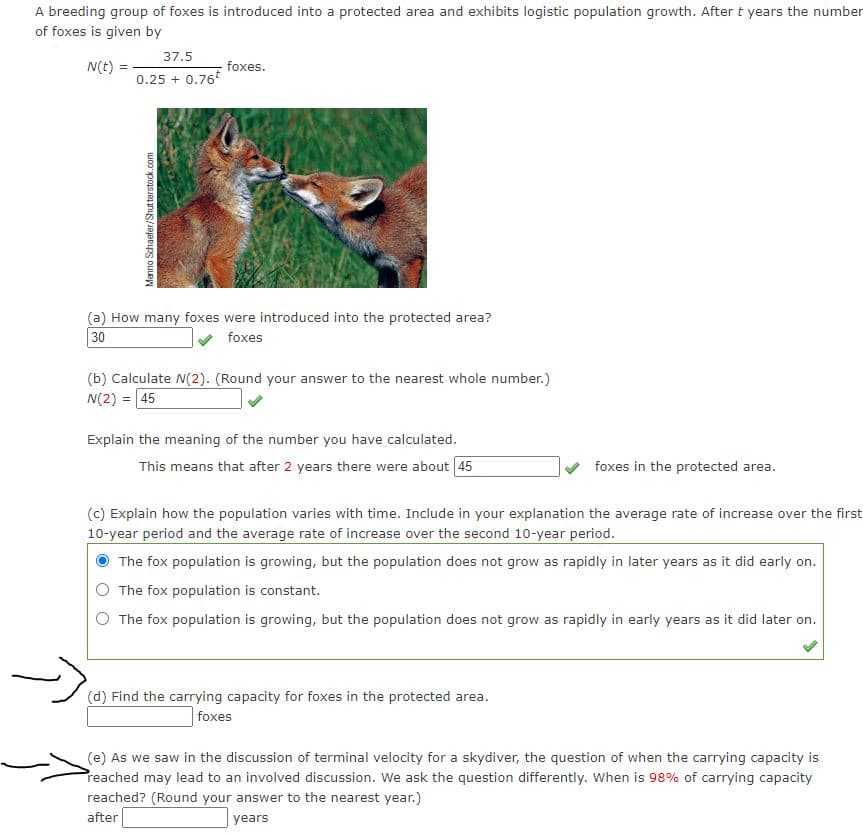A breeding group of foxes is introduced into a protected area and exhibits logistic population growth. After t years the num of foxes is given by 37.5 N(t) = 0.25 + 0.76 - foxes. (a) How many foxes were introduced into the protected area? 30 foxes (b) Calculate N(2). (Round your answer to the nearest whole number.) N(2) = 45 Explain the meaning of the number you have calculated. This means that after 2 years there were about 45 foxes in the protected area. (c) Explain how the population varies with time. Include in your explanation the average rate of increase over the f 10-year period and the average rate of increase over the second 10-year period. The fox population is growing, but the population does not grow as rapidly in later years as it did early on. The fox population is constant. O The fox population is growing, but the population does not grow as rapidly in early years as it did later on. (d) Find the carrying capacity for foxes in the protected area. foxes (e) As we saw in the discussion of terminal velocity for a skydiver, the question of when the carrying capacity is Preached may lead to an involved discussion. We ask the question differently. When is 98% of carrying capacity reached? (Round your answer to the nearest year.) after years Manno Schaefer/Shut terstock.com
Family of Curves
A family of curves is a group of curves that are each described by a parametrization in which one or more variables are parameters. In general, the parameters have more complexity on the assembly of the curve than an ordinary linear transformation. These families appear commonly in the solution of differential equations. When a constant of integration is added, it is normally modified algebraically until it no longer replicates a plain linear transformation. The order of a differential equation depends on how many uncertain variables appear in the corresponding curve. The order of the differential equation acquired is two if two unknown variables exist in an equation belonging to this family.
XZ Plane
In order to understand XZ plane, it's helpful to understand two-dimensional and three-dimensional spaces. To plot a point on a plane, two numbers are needed, and these two numbers in the plane can be represented as an ordered pair (a,b) where a and b are real numbers and a is the horizontal coordinate and b is the vertical coordinate. This type of plane is called two-dimensional and it contains two perpendicular axes, the horizontal axis, and the vertical axis.
Euclidean Geometry
Geometry is the branch of mathematics that deals with flat surfaces like lines, angles, points, two-dimensional figures, etc. In Euclidean geometry, one studies the geometrical shapes that rely on different theorems and axioms. This (pure mathematics) geometry was introduced by the Greek mathematician Euclid, and that is why it is called Euclidean geometry. Euclid explained this in his book named 'elements'. Euclid's method in Euclidean geometry involves handling a small group of innately captivate axioms and incorporating many of these other propositions. The elements written by Euclid are the fundamentals for the study of geometry from a modern mathematical perspective. Elements comprise Euclidean theories, postulates, axioms, construction, and mathematical proofs of propositions.
Lines and Angles
In a two-dimensional plane, a line is simply a figure that joins two points. Usually, lines are used for presenting objects that are straight in shape and have minimal depth or width.
D and E

Trending now
This is a popular solution!
Step by step
Solved in 3 steps









